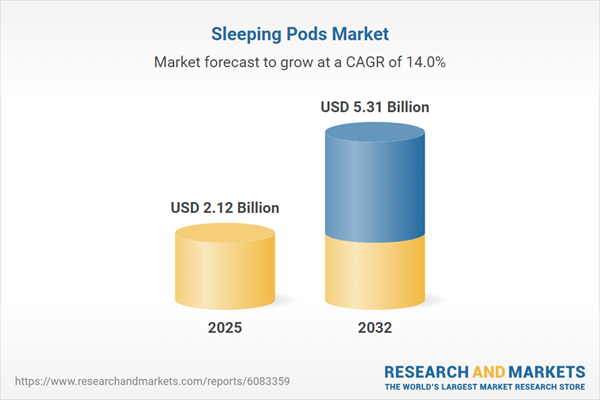Speak directly to the analyst to clarify any post sales queries you may have.
Discover how the global sleeping pods market is unlocking adaptable comfort and wellness solutions for modern workplaces, transit, healthcare, and hospitality environments. Industry leaders are leveraging smart innovation and regional production strategies to address demand for privacy, productivity, and modular real estate optimization.
Market Snapshot: Sleeping Pods Market Growth and Opportunities
The sleeping pods market grew from USD 1.86 billion in 2024 to USD 2.12 billion in 2025. It is expected to continue growing at a CAGR of 13.99%, reaching USD 5.31 billion by 2032. This growth reflects rising urban density, remote work trends, and evolving requirements for occupant well-being in both commercial and public environments. Organizations are prioritizing flexible, privacy-focused installations that maximize space and respond to diverse usage needs.
Scope & Segmentation Overview
This report delivers comprehensive segmentation and in-depth analysis to help senior decision-makers evaluate prospects across the sleeping pods value chain. Key segmentations include:
- Pod Types: Capsule (nano, smart, standard), modular (customizable, prefab), standalone (fixed, portable)
- Applications: Commercial (co-working, office spaces, retail outlets), healthcare (assisted living, clinics, hospitals), hospitality (hostel, hotel, resort), residential (apartments, dormitories, villas), transportation (airports, bus terminals, railway stations)
- End Users: Corporate offices (large enterprises, SMEs), healthcare facilities (clinics, hospitals), hospitality providers (hotel chains, independent hotels), individual (adult, child, teen), transportation hubs (airports, bus stations, train stations)
- Distribution Channels: Offline (direct sales, distributors, specialty stores), online (e-commerce platforms, manufacturer websites, third-party retailers)
- Deployment Modes: Indoor (permanent, semi-permanent), outdoor (fixed, portable)
- Price Ranges: Budget (economy, entry-level), luxury (VIP category), premium (high-end, mid-range), standard (commercial grade, residential grade)
- Occupancy Options: Single, double, multi (dormitory pods, family pods)
- Material Choices: Composite (carbon fiber, fiberglass), metal, plastic, wood
Regional analysis covers the Americas (North and Latin America), EMEA (Europe, Middle East, Africa), and Asia-Pacific territories, each with distinctive growth patterns and adoption drivers.
Sleeping Pods Market: Key Takeaways for Strategic Decision-Makers
- Industry stakeholders are capitalizing on ergonomic designs, acoustic performance, and digital environment controls to differentiate sleeping pod offerings and enhance occupant satisfaction.
- Deployment flexibility remains vital, with organizations favoring pods that can adapt to changing layouts, use cases, and wellness requirements within office, transit, and healthcare settings.
- Smart technology integration is advancing rapidly, making real-time personalization of lighting, climate, and comfort standard expectations within premium pod product lines.
- Sustainability is now core to material sourcing, as manufacturers prioritize recyclable structures and energy-efficient systems to support global decarbonization initiatives.
- Niche challengers are focusing on innovation in compact form factors and sustainable components to compete with leading incumbents in micro-living and urban applications.
Tariff Impact and Competitive Positioning
The updated 2025 United States tariff policy has shifted supply chain priorities, encouraging domestic production and greater transparency in value chains. Manufacturers and component suppliers have reorganized to strengthen regional alliances, ensuring margin stability and supply reliability.
This competitive environment now features established manufacturers with integrated R&D, wellness partners for biometric feature integration, and agile startups targeting sustainability-driven market segments. Strategic alliances and pilot programs across co-working, healthcare, and hospitality networks have facilitated market reach, with after-sales support emerging as a value differentiator.
Research Methodology & Data Sources
This report is grounded in a multi-source research framework. Primary stakeholder interviews, executive discussions, and site visits informed qualitative findings. Secondary sources included technical literature, patent analysis, and regulatory reviews. Triangulated quantitative methods validated segmentation structures and market trends.
Why This Report Matters
- Identify actionable strategies to optimize supply chains, product innovation, and market expansion in the evolving sleeping pods sector.
- Benchmark product features and design roadmaps against emerging best practices for modularity, wellness integration, and digital intelligence.
- Evaluate regional adoption dynamics to inform localization and risk mitigation strategies in challenging trade environments.
Conclusion
As sleeping pods transition toward mainstream multifunctional adoption, decision-makers have a strategic opportunity to drive value through modular innovation, sustainable sourcing, and data-driven operations. This report equips leaders with critical insights for navigating the future of workplace, hospitality, healthcare, and residential sleep solutions.
Table of Contents
3. Executive Summary
4. Market Overview
7. Cumulative Impact of Artificial Intelligence 2025
List of Figures
Samples

LOADING...
Companies Mentioned
The key companies profiled in this Sleeping Pods market report include:- GoSleep OY
- MetroNaps Inc.
- Sleepbox LLC
- NAPCabs GmbH
- OSD Factory SAS
- Somnox BV
- Podtime Pty Ltd.
- Snoozecube BV
- DreamPod Europe Ltd.
- Rest-Room Technologies Inc.
Table Information
| Report Attribute | Details |
|---|---|
| No. of Pages | 181 |
| Published | October 2025 |
| Forecast Period | 2025 - 2032 |
| Estimated Market Value ( USD | $ 2.12 Billion |
| Forecasted Market Value ( USD | $ 5.31 Billion |
| Compound Annual Growth Rate | 13.9% |
| Regions Covered | Global |
| No. of Companies Mentioned | 11 |








